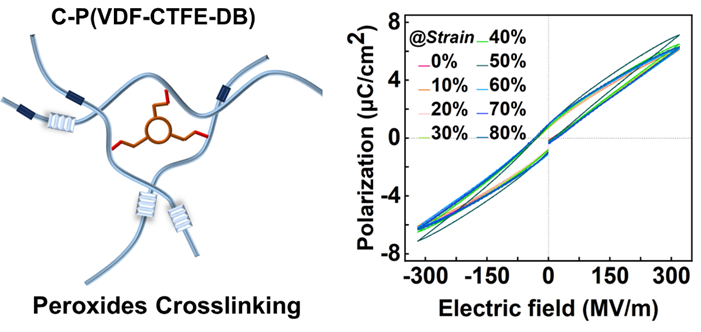过氧化物交联增强的应变不敏感弹性弛豫性铁电材料
弛豫性铁电材料是一类在广泛应用领域中受到关注的铁电材料,其独特的电学特性使其在传感器、存储器和致动器等方面表现出色。去年团队首次提出利用精确的微交联法成功实现了PVDF基聚合物铁电材料的弹性化,但在弛豫性铁电聚合物中实现弹性仍然是一个重大挑战。这些材料具有低结晶度和小晶体尺寸的特性,而化学交联往往会大大降低聚合物的结晶度。因此,使弛豫铁电聚合物具有弹性的关键障碍在于保护其晶体区域免受轻微交联的影响。
针对这一挑战,前沿交叉科学研究中心胡本林研究员带领研究团队采用过氧化物交联弛豫性铁电聚合物得到兼具高介电常数和高弹性回复的弛豫性铁电弹性体。该工作选择了具有高活性碳碳双键的P(VDF-CTFE-DB)作为交联反应基材料以减少交联剂的添加量,从而减少了它们对结晶度的影响。通过过氧化物交联,使线性P(VDF-CTFE-DB)转化为网络结构,成功地制备出具有应变不敏感的弹性弛豫性铁电材料。值得注意的是,这种弹性弛豫铁电是在相对较低的温度下合成的,具有较高的介电常数,优越的回弹性,耐疲劳性,即使在高达80%的应变下也具有稳定的铁电响应。这种方法为开发低成本、高介电常数弹性体提供了新思路。
相关研究成果以“Highly Elastic Relaxor Ferroelectric via Peroxide Crosslinking”为题,发表于英国皇家化学会期刊 Chemical Science 2024, 15, 15432-15439(https://doi.org/10.1039/D4SC04641B)。感谢浙江省自然科学基金委员会杰出青年基金项目LR24E030003和浙江省钱江人才计划ZJ-QJRC-2020-32资助。

图1 过氧化物交联网络及应变下的铁电性能响应
Frontier Interdisciplinary Research Center
Progress in Elastic Relaxor Ferroelectric Elastomers by the Flexible Ferroelectric Materials and Devices Group
Relaxor ferroelectric materials have attracted significant attention due to their unique electrical properties, making them highly promising for applications in sensors, memory devices, and actuators. However, imparting elasticity to these materials remains a considerable challenge. Last year, the research team pioneered a precise slight-crosslinking strategy to achieve elasticity in PVDF-based ferroelectric polymers. Nevertheless, introducing elasticity into relaxor ferroelectric polymers continues to be a major obstacle.
Relaxor ferroelectric polymers are characterized by low crystallinity and small crystal sizes, and conventional chemical crosslinking methods often further reduce their crystallinity. Therefore, the key challenge in developing elastic relaxor ferroelectric polymers lies in protecting the crystalline regions from the effects of crosslinking.
Recently, a research team led by Dr. Hu Benlin at the Ningbo Institute of Materials Technology and Engineering, Chinese Academy of Sciences, successfully fabricated highly elastic relaxor ferroelectric elastomers with both high dielectric permittivity and excellent elasticity via peroxide crosslinking. The team selected P(VDF-CTFE-DB), a copolymer containing highly reactive carbon-carbon double bonds, as the base material for crosslinking, enabling a significant reduction in crosslinker content and minimizing its impact on crystallinity. By employing peroxide crosslinking, linear P(VDF-CTFE-DB) was transformed into a network structure, yielding an elastic relaxor ferroelectric material with strain-insensitive properties.
Notably, this material can be synthesized at relatively low temperatures while exhibiting outstanding comprehensive performance, including high dielectric permittivity, excellent resilience, and superior fatigue resistance. Even under strains of up to 80%, the ferroelectric response remains stable. This study offers a new strategy for the development of low-cost, high-permittivity elastic ferroelectric materials.
The findings have been published in the Royal Society of Chemistry journal Chemical Science under the title "Highly Elastic Relaxor Ferroelectric via Peroxide Crosslinking."

Figure 1. Peroxide crosslinked network and ferroelectric performance response under strain


